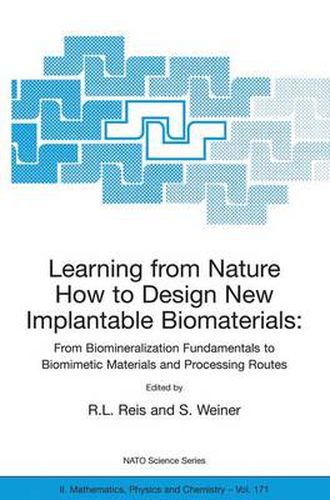Readings Newsletter
Become a Readings Member to make your shopping experience even easier.
Sign in or sign up for free!
You’re not far away from qualifying for FREE standard shipping within Australia
You’ve qualified for FREE standard shipping within Australia
The cart is loading…






This title is printed to order. This book may have been self-published. If so, we cannot guarantee the quality of the content. In the main most books will have gone through the editing process however some may not. We therefore suggest that you be aware of this before ordering this book. If in doubt check either the author or publisher’s details as we are unable to accept any returns unless they are faulty. Please contact us if you have any questions.
The development of materials for any replacement or regeneration application should be based on the thorough understanding of the structure to be substituted. This is true in many fields, but particularly exigent in substitution and regeneration medicine. The demands upon the material properties largely depend on the site of application and the function it has to restore. Ideally, a replacement material should mimic the living tissue from a mechanical, chemical, biological and functional point of view. Of course this is much easier to write down than to implement in clinical practice. Mineralized tissues such as bones, tooth and shells have attracted, in the last few years, considerable interest as natural anisotropic composite structures with adequate mechanical properties. In fact, Nature is and will continue to be the best materials scientist ever. Who better than nature can design complex structures and control the intricate phenomena (processing routes) that lead to the final shape and structure (from the macro to the nano level) of living creatures? Who can combine biological and physico-chemical mechanisms in such a way that can build ideal structure-properties relationships? Who, else than Nature, can really design smart structural components that respond in-situ to exterior stimulus, being able of adapting constantly their microstructure and correspondent properties? In the described philosophy line, mineralized tissues and biomineralization processes are ideal examples to learn-from for the materials scientist of the future.
$9.00 standard shipping within Australia
FREE standard shipping within Australia for orders over $100.00
Express & International shipping calculated at checkout
This title is printed to order. This book may have been self-published. If so, we cannot guarantee the quality of the content. In the main most books will have gone through the editing process however some may not. We therefore suggest that you be aware of this before ordering this book. If in doubt check either the author or publisher’s details as we are unable to accept any returns unless they are faulty. Please contact us if you have any questions.
The development of materials for any replacement or regeneration application should be based on the thorough understanding of the structure to be substituted. This is true in many fields, but particularly exigent in substitution and regeneration medicine. The demands upon the material properties largely depend on the site of application and the function it has to restore. Ideally, a replacement material should mimic the living tissue from a mechanical, chemical, biological and functional point of view. Of course this is much easier to write down than to implement in clinical practice. Mineralized tissues such as bones, tooth and shells have attracted, in the last few years, considerable interest as natural anisotropic composite structures with adequate mechanical properties. In fact, Nature is and will continue to be the best materials scientist ever. Who better than nature can design complex structures and control the intricate phenomena (processing routes) that lead to the final shape and structure (from the macro to the nano level) of living creatures? Who can combine biological and physico-chemical mechanisms in such a way that can build ideal structure-properties relationships? Who, else than Nature, can really design smart structural components that respond in-situ to exterior stimulus, being able of adapting constantly their microstructure and correspondent properties? In the described philosophy line, mineralized tissues and biomineralization processes are ideal examples to learn-from for the materials scientist of the future.